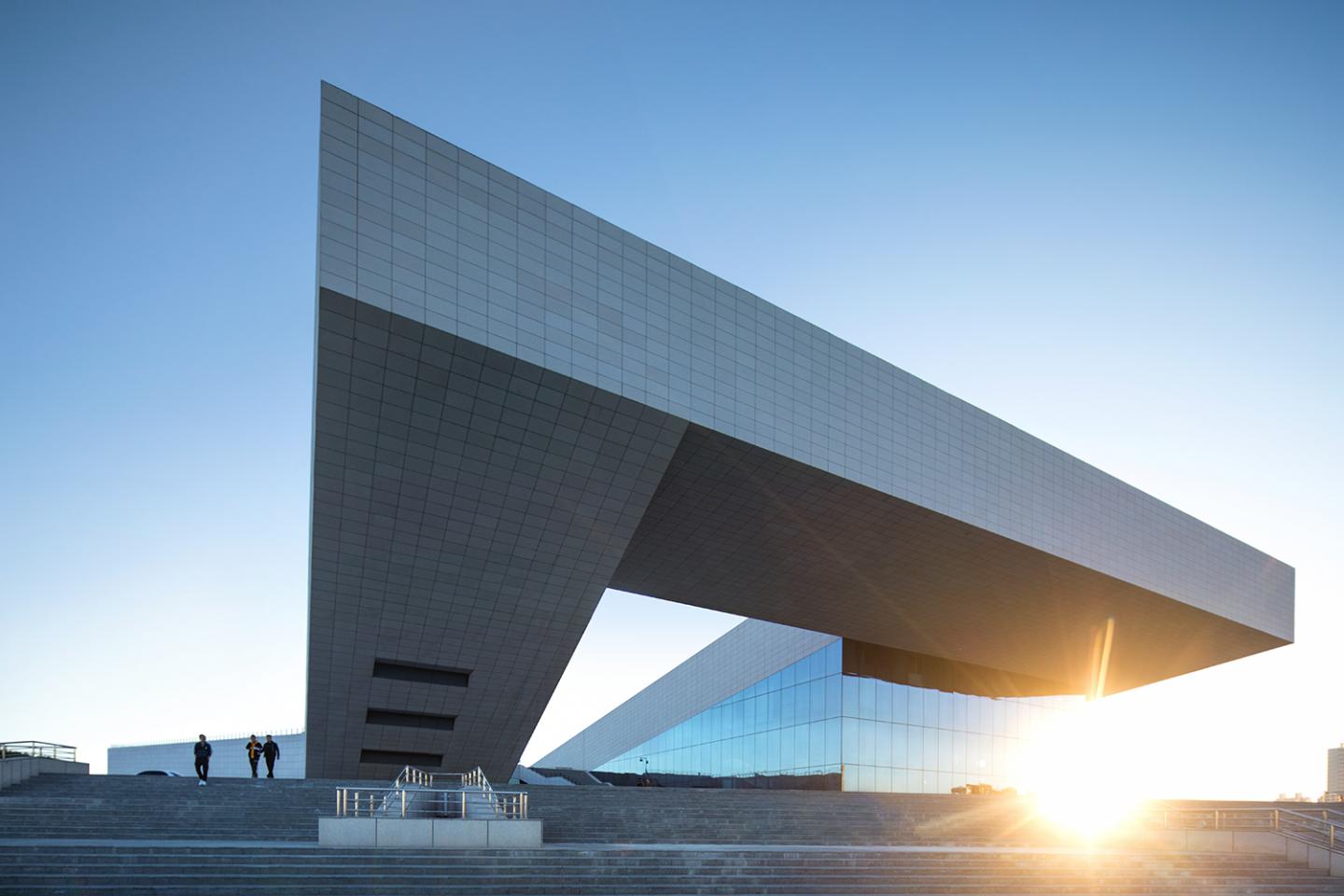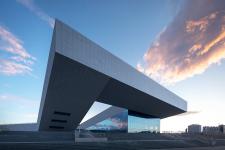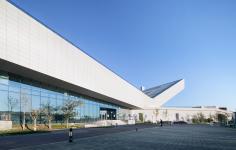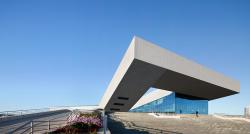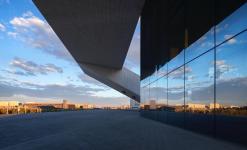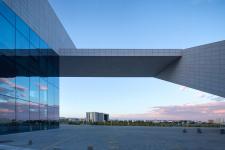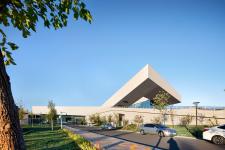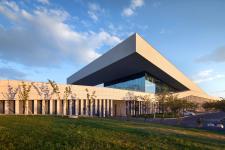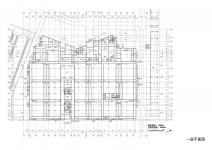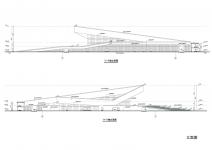Project Background
PetroChina’s Xinjiang Regional Data Network Control Center in Karamay is a new headquarter building for production management, data monitoring and server facilities. To improve its production management and strategize an information network for its oil fields, PetroChina Xinjiang Oilfield Company organized a competition, in which Shanghai HuaDu Architecture and Urban Design Group (HDD) had won and was commissioned to design the building.
The project will function as an efficient, centralized headquarter for information resource management that will further assist Xinjiang to develop its municipal information infrastructure. With a gross floor area of 48,961 m2, and a planning area of 65,521 m2, the building intersects server rooms for Digital City Data Center, PetroChina Data Center, and Cloud Computing Center. This converges urban information resources including multimedia information networks, geographic information system and other information infrastructures. With a long-term goal to construct an organized, multifunctional smart city information system, the frameworks for e-government, e-commerce, science and education information, social security information, distant learning and telemedicine will be gradually set up.
Design Concept
The data network control center took the design concept of “an ark floating on the wavy dunes of the Gobi Desert”, in a dynamic geometric form that symbolizes a ship’s bow rising from tides. The concept is articulated through a set of modern design languages. The entrance space framed by a 30m cantilevered steel structure and horizontal steps creates an imposing spatial experience. Its bold figure reshapes the skyline of the Karamay oil field’s administrative area.
The façade is composed of warm grey aluminum honeycomb panels to emphasize solid massing in contrast with the foyer’s large glass wall. To balance the visual heaviness of the upper part of the building, the floor and entrance steps are tiled with dark stone. Viewed from a distance, the center’s volume conveys a sense of momentum and vigor.
To accurately unite its form of an ark floating beyond the base and its high-standard function, the design uses a staggered plan. With the height of the roof falls from 31.17m to 11.20m, floor plans and enclosing walls become irregular as floors spilt into staggered layers. The project was listed ‘exceed-code irregular building structure’ in China, and thus has gone through an examine-and-approve process in terms of seismic performance. With an in-depth research and unique technical breakthroughs supported by data, the design team demonstrated the project in a jury formed by exceed-code structure specialists and eventually gained approval from the authority.
T4 Standard Data Center
The data network control center is vertically zoned by two major programs: 1) Server rooms and related facilities that locate on the ground floor and basement, using the base of the building volume and the space below the entrance steps. 2) The exhibition area that takes up the upper part of the building, including space for reception, leisure and office. First floor is for command center and auditorium. Second floor, third floor, and staggered floors in between are for offices.
The server facility space is designed under high security standards due to its municipal significance. HDD cooperates with International Business Machines Corporation (IBM) to develop its design, by introducing the standard Tier Classification System created by Uptime Institute into design evaluation. Uptime Institute is the most renowned and authoritative third-party organization to evaluate data centers and set standards at present. The center’s design follows a Tier IV standard of the Data Center Site Infrastructure Tier Standard, which ensures the infrastructure’s serviceability, reliability, functional capacity, and easy maintenance. This will provide international first-class standard physical environment and data services to PetroChina Xinjiang Oilfield Company.
Circulation
The project’s circulation design is also conceived through overlaying security requirements with program zoning. Different user groups and interflows of goods have separate access control. Vertical program zoning minimizes the chance of visitor circulation intersecting with service circulation. The majority of office staffs and visitors are directed to the first floor entrance through steps. Two entrance halls separated by an atrium channel different groups of visitors, one for inspectors from the authority, the other for group visitors. Devices and staffs working at server rooms enter through service entrances on the east and west side of the building.
The internal visiting route is separated by hi-tech measures. A ramp gallery wanders through staggered floors and surrounds the command center hall. The emergency response center is isolated in glass walls with electric blinds. To maintain a good acoustic environment for the center, the electric blinds can be automated into different modes, and thus adapt for various visiting purposes.
External visiting activities follow a circular route with a rich spatial hierarchy of landscapes. Following a circular ramp surrounding the central courtyard, different layers of landscape will unfold before visitors reaching the top of the roof for a open view. The project’s landscape design is conceived with different spatial conditions created by the massing. The waterscape and parterre form a coherent interface with the horizontal entrance steps. Vegetated green spaces surrounding the building create a dialogue and a rich layer of landscape. Green atriums shape beautiful micro-environments within the building, so as to form a balanced, humanistic relationship between nature and the built environment.
2012
2018
Location: Karamay, XinJiang, China
Typology: Office
Status: Completed
Floor space: 48961㎡
Complete Time: 2018
Photograph: arch-exist (http://www.arch-exist.com)
Construction: Shanghai HuaDu Architecture & Urban Design Company (HDD)
Chief Designer: Dong Weiwei
Architectural Design: Shen Yi, Dong Weiwei, Qiu Ying, He Yuwei, Jiang Airong, Zhang Xin
Structural Design: Zhou Zhen, Yuan Zhili, Wang Guoxun, Zhang Yongqiang, Qi Xiaozhe, Li Meiqi
Electrical Design: Ren Fusheng, Zhang Xiaoqing, Zhang Yi, Cao Yujie, Cheng Yu
Water Supply and Drainage Design: Jiang Yi, Cheng Luhua, Song Limin, Zhang Wei, Gao Li
HVAC Design: Chai Yunliang, Cheng Lingsong, Qu Dongyang, Luo Tao
